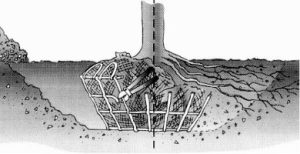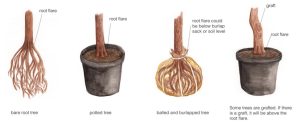Question: I was gifted a flowering dogwood tree (Cornus florida) from my family recently. It is 6 feet tall and the root ball is wrapped in burlap. What are best planting practices to ensure my new tree survives and thrives?
By Melissa Otoya, Piedmont Master Gardener Intern
Flowering dogwoods add year-round beauty to the landscape. Native to the northeastern and southeastern U.S., they are fully adapted to thrive in Virginia’s climate and soils. They provide food for bees, butterflies, songbirds, and other pollinators, as well as shelter and habitat for wildlife. These trees produce showy white to pinkish blossoms in the spring, red to maroon foliage, and small shiny oval red fruits in the fall. Their attractive blocky grey bark and onion-dome shaped buds also provide winter interest. Designated as Virginia’s state tree and flower, the flowering dogwood was also named the 2018 Wildflower of the Year by the Virginia Native Plant Society.
Historically, its natural habitat included forests (typically as an understory tree shaded by larger trees), in clearings, old fields, and floodplains. Since the late 1970’s, a fungal disease called dogwood anthracnose (Discula destructiva) has destroyed over 95% of these native plants in some areas, particularly at higher elevations (>2000 ft; esp. >3000 ft), where consistent cool, moist conditions persist.
Right Plant, Right Place
Since you already have the tree, it is important to plant it as soon as possible. But first, you will need to determine the right site for planting your tree. In the meantime, remember to keep the wrapped root ball of the tree moist and in a shaded or sheltered spot.

Placement of the tree: light and soil considerations
Flowering dogwoods can be planted in partial shade to mimic its natural environment (2 to 4 hours direct sun) or partial sun, preferably with morning sun and afternoon shade (4 to 6 hours direct sun). Dogwoods in partial sun tend to have a stouter, bushier growth habit and have more abundant blooms than those grown in partial shade. They can even be grown in full sun. Good air circulation is essential, as well as adequate irrigation, especially in the hotter months.
They grow best in course to medium-textured, well-drained, fertile soils with a pH range of 5.6 – 6.5 (mildly acidic). The root system is comparatively shallow and intolerant of severe drought or heavy saturated soils. The site should be able to accommodate the size of the mature tree (10 – 20 ft. height and 15 – 25 ft. width). In addition to suitable site conditions, be sure to consider the visual appeal of the location within the overall landscape. To ensure your site is appropriate, be sure to have the soil tested, follow soil test recommendations and these do-it-yourself tests for soil consistency and drainage can help you determine the soil quality.

Planting the tree
As a general rule, trees can be planted at any time of year, except for during very hot weather, droughts or when the ground is frozen. However, the best time to plant is the late fall, winter or early spring when trees are dormant. This North Carolina State University video summarizes the steps to planting a burlap wrapped tree, which are described in more detail below.
Before starting, collect the tools you may need, including a shovel or spade, tarp, garden scissors or hand pruners, wire or bolt cutter, hose to a water source and mulch.
- Call Miss Utility of Virginia before any digging to prevent damage of underground utilities and ensure your safety.
- Locate the “root flare”. This is where the trunk flares and roots begin to emerge. Gently remove any excess soil to expose the root flare and ensure oxygen and nutrient uptake to keep roots healthy.
- Dig a hole to the depth of the root ball, as measured from root flare to bottom of root ball. The width of the hole should be at a minimum 2–3 times the size of the root ball. If soil is very compact, make the hole wider to encourage lateral root growth. Do not dig too deeply as root flare should be at top of soil level. Do not disturb the soil underneath where the root ball will sit to avoid settling, which could result in the root flare being buried beneath the soil surface. Place the soil removed from the hole atop the tarp to facilitate backfilling the hole.
- Carefully lower the root ball into the hole with burlap still in place. Carry the specimen by the root ball, instead of picking it up by the trunk to avoid damage to the roots and trunk. Position the tree so that the root flare will be at the soil level. Set a shovel handle or yardstick horizontally across the planting hole to check the root flare’s position. Carefully adjust the flare to make sure tree is straight. Avoid breaking or cracking soil around the roots. Make sure the best side of the tree can be viewed and appreciated.
- Remove any twine or cord around the trunk and cut the burlap away from root ball. Remove burlap as much as possible so it does not hamper root growth. Cut any circling roots and remove damaged ones.
- If a wire basket is used, cut it off with wire cutters. Remove as much as possible without disturbing the root ball; at a minimum, the top 12 inches of the basket should be removed.
- Backfill with the same soil removed from the hole. Fill the hole three-fourths full, straighten the tree, water deeply and then fill hole to its original level. Do not add organic material, which can impair drainage and impede root growth. If there are stones or debris in backfill, remove it and fill with local topsoil.
- Use excess soil to build a ring 6 to 10 inches from the edge of the hole to direct water to the roots. Water to fill any air pockets in the soil.
- Apply 2-3 inches of mulch (pine needles, straw, bark chips or shredded leaves) in a donut shaped ring around the tree and outwards at least to the outer edge of the tree canopy (the drip line). Do not pile mulch in a mulch “volcano” at base of the trunk. Mulch helps to retain moisture, reduces injury to the tree from gardening equipment and lessens the risk of pests or disease.
- For the first 2 weeks after planting, check soil moisture daily and water deeply in the morning, if the top 6 inches of soil feels dry to the touch. During the first two years, check the soil moisture weekly and water, as needed. Most of the trees that die in the first year die because of either too little or too much watering.
- Because of their shallow roots, dogwood trees over 4 feet tall may need to be staked for a couple growing seasons. Drive three stakes into firm soil and connect to the trunk with flexible straps that allow for growth.
Taking these steps will go a long way toward ensuring a healthy start for your flowering dogwood. Be sure to follow best management practices as your new tree continues to grow. The Charlottesville Area Tree Stewards presentation on selecting, planting and caring for your tree and Virginia Cooperative Extension brochure on planting trees are good guides to these practices.
If you decide to plant more dogwoods, consider some of the more disease-resistant now on the market. You may also want to consider some of the other Virginia native trees, particularly the keystone tree varieties.
Featured Image by Gretchen Spencer, Fairfax County Master Gardeners
References
“Determining Soil Texture By the Feel Method” , Colorado State University, Modified from Thien, Steve J., Kansas State University,1979.
“DIY Soil Drainage Perk Test for Your Yard” Dismukes, Amy, Horticulture Extension Agent, Tennessee State University, Cooperative Extension and University of Tennessee, UT Extension.
“Dogwoods – Spring in Virginia”, Martin, Susan, The Garden Shed, Piedmont Master Gardeners.
“Flowering Dogwood, Cornus florida”, Niemiera, Alex X, Professor, School of Plant and Environmental Sciences, Virginia Tech, Publication 3010-1484, 2018.
“Flowering Dogwood: Cornus Florida”, U.S. Department of Agriculture, Natural Resources and Conservation Service, Plant Fact Sheet, 2002.
“Foliar Diseases of Dogwoods”, Hansen, Mary Ann, Virginia Tech, Virginia Cooperative Extension, Publication 450-611, 2009.
Planting Trees, Niemiera, Alex X, Professor, School of Plant and Environmental Sciences, Virginia Tech, Virginia Cooperative Extension, Virginia Gardener, Publication 426-702, 2017.
“Planting a Tree or Shrub”, University of Maryland, University of Maryland Extension, 26 Feb. 2024.
“Our Official State Tree”, Spencer, Gretchen, Fairfax Gardening, Fairfax County Masters, 2023.
“Planting Balled and Burlapped Trees and Shrubs in Your Landscape” Fountain, William M. and Vanek, Sarah J., Horticulture, University of Kentucky, College of Agriculture, Cooperative Extension Service, Publication HO-9, 2021.
“Wildflower of the Year 2018 Flowering Dogwood” Hayden, W. John, VNPS Botany Chair, Virginia Native Plant Society, 2018.